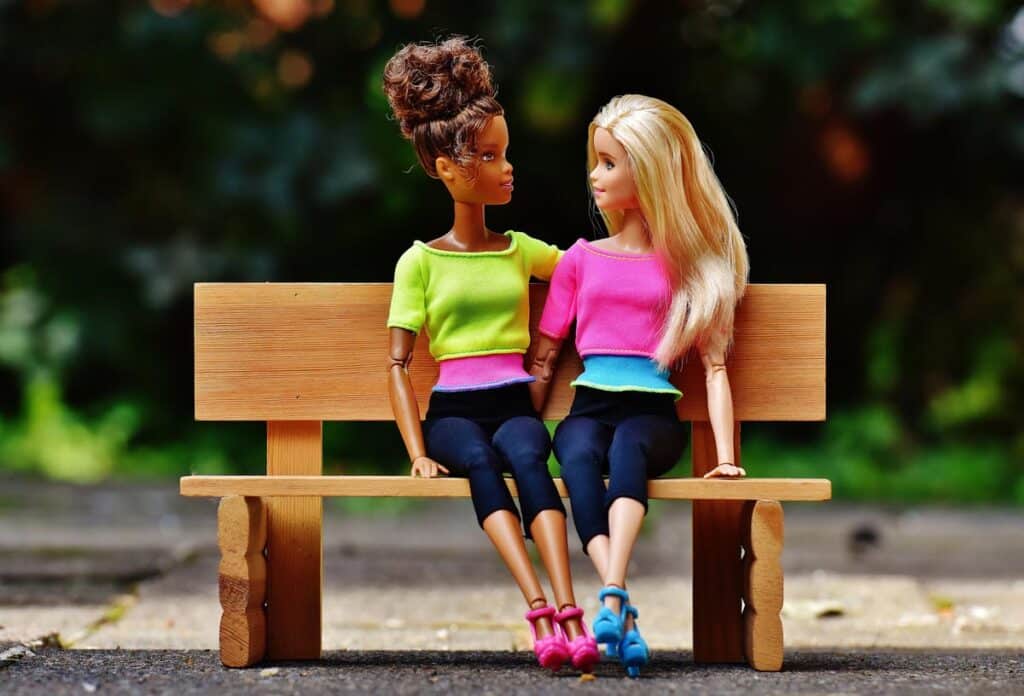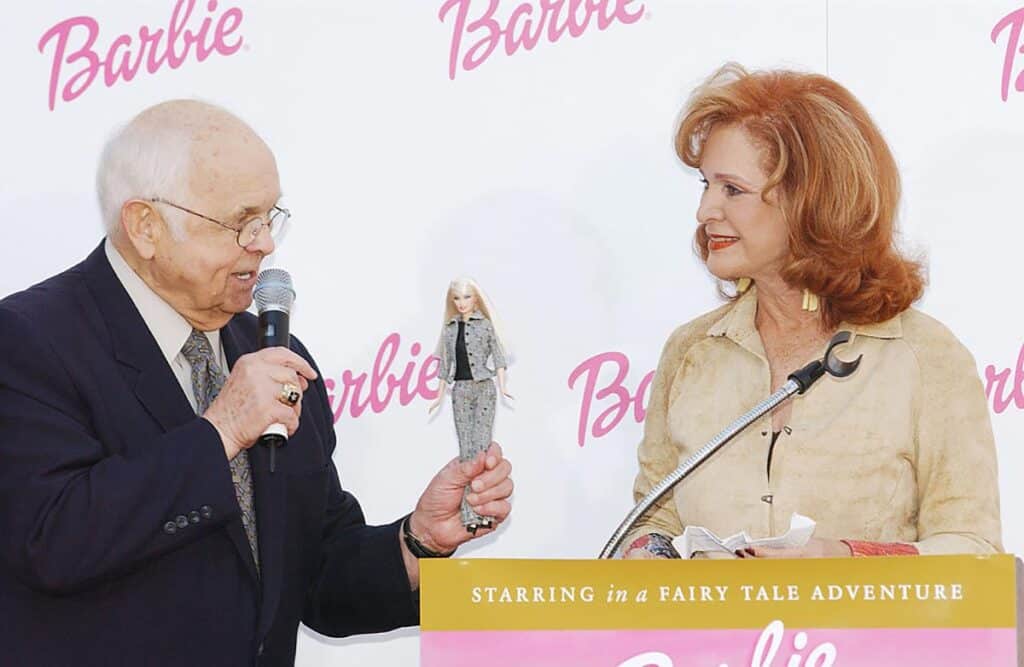
“She’s everything. He’s just Ken.” That’s the belief system that Barbie was created under — and the tagline for Greta Gerwig’s new “Barbie” movie.
Since her release in 1959, Barbie has inspired children across the world to chase their dreams because Barbie can do anything she puts her mind to — from being an astronaut to a fashion designer to president.
But did you know the iconic doll has a rich Jewish history? Before you get swept into the hot pink magic of the “Barbie” movie, which will be released in theaters this weekend, get to know her lesser-known Jewish roots.
Ruth Handler, the Jewish woman behind Barbie
Barbie was created by Ruth Handler, born Ruth Moskowicz in 1916. Handler was the youngest child of 10 born to Polish Jewish immigrants in Denver, Colorado (which might explain why Barbie has so many friends and family members coming in and out of the Dream House).
Ruth worked at her aunt’s store as a teenager, which taught her the basics of business management — and made her decide that she wanted to run her own business some day.
Handler grew up extremely poor and when she was young, her mother became ill and could no longer raise her. Handler’s oldest sister Sarah became Ruth’s surrogate mother, taking her in. Sarah had no children of her own and worked, which was rare at the time, and became a role model for Ruth.
When she was 16, she met her future husband Elliot Handler at a B’nai Brith (Jewish youth) dance. Elliot was an artist and went to art school to pursue his passion.
Ruth fell in love with California while on a trip during her sophomore year at the University of Denver. That trip inspired her to drop out and move out west. Elliot soon followed her to Los Angeles.
Ruth got a job as a secretary at Paramount Pictures. Her family allowed her to live with a female friend in an apartment and drive her own car, which was practically unheard of in the early 1930s.
In another breaking of the norms, when they were both 22 years old, Ruth proposed to Elliot and they got married in 1938.
In Los Angeles, the Handlers founded a plastic and wood business; the duo made props and toys for Hollywood studios. Eventually, the Handlers, along with Elliot’s colleague Matt Matson, founded Mattel. The company was named as a combination of Matt and Elliot.
While Ruth’s name was left out of the company’s, her role in Mattel’s success far outshined either man’s.
The creation of Barbie

The origins of Barbie go back to when Ruth watched her daughter Barbara — whom Barbie was named for — play with paper dolls, which dominated the doll market at the time. Handler noticed that Barbara was most interested in the grown women dolls which she could dress in different ways.
Handler realized that there was a gap in the market as the options for young girls at the time were mostly limited to paper dolls. She also realized that not every girl wanted to play with toys contained within the domestic sphere. Her daughter was interested in the full range of possibilities that existed for adults.
So, Handler decided to create a doll for young girls that resembled adult women with breasts and hips that could be dressed in lifelike clothes of any profession they aspired to pursue. Handler wanted a doll that reflected her own goals as a working woman to inspire young women to pursue the workforce and careers.
“Barbara and her friends always insisted on playing with adult female paper dolls. They were simply not interested in baby paper dolls or even those representing ten-year-olds, their own age,” Handler wrote in her autobiography “Dream Doll.”
“I discovered something very important: They were using these dolls to project their dreams of their own futures as adult women,” she added.
While on a family trip to Switzerland in 1956, Handler found the inspiration she needed to create the first Barbie. She came across a German doll called Bild Lilli, which was marketed for adults based on a German cartoon.
The Lilli doll was voluptuous and created for German men to buy for their girlfriends as a suggestive gift. At the time, the tagline for Lilli was that “Gentlemen prefer Lilli. Whether more or less naked, Lilli is always discreet.”
Handler felt that Lilli’s womanly shape and mature looks were exactly what she envisioned for the dolls she wanted to release. She brought the Lilli doll back with her and used it as a starting point for the Barbie doll.
Three years later, in 1959, the first Barbie was released. Barbie would never get married or become a mother. Barbie came in a white-and-black swimsuit, trendy white sunnies and non-removable heels.

In 1961, to keep up with the Barbie demand, Mattel released Ken, a male counterpart for Barbie. Ken was named for the Handlers’ son, Kenneth.
Barbie shook up the game because she had a variety of adult outfits, and a job. While the Mattel board was skeptical, the first Barbie sold 350,000 units its first year and kick-started what would become a revolution.
Over the decades, the doll has continued to change as society has, adapting to trends, tastes and historical events. As of 2020, Barbie is produced in eight body shapes, 35 skin tones and 94 hairstyles.
So, is Barbie Jewish?
It depends on your interpretation. Barbie was modeled after Handler herself as an independent, working woman, and was named for her daughter Barbara. The person who created the doll was Jewish.
While Barbie and Ken are not explicitly Jewish, you can order a Barbie Shabbat set and Jewish-themed clothes and accessories, but they are not manufactured by Mattel. However, the people Barbie and Ken were molded after and for were Jewish.
Did you know #Barbie is Jewish? That's right! Barbie wouldn't be Barbie without the #JewishIcon behind her, Ruth Handler, the doll's inventor. 💅 pic.twitter.com/n3SJ05FiAJ
— Weitzman NMAJH (@weitzmanmuseum) April 14, 2023
While to many, the original Barbie is a symbol of an Anglo-Saxon woman with blonde hair and an unattainable figure, others have seen her as a Jewish icon, and the doll has even been a target of antisemitism.
In 2003, Saudi Arabia outlawed the sale of Barbie dolls. The state’s religious police wrote: “Jewish Barbie dolls, with their revealing clothes and shameful postures, accessories and tools are a symbol of decadence to the perverted West. Let us beware of her dangers and be careful.” Apparently, 12-inch dolls also have Jewish space lasers, which is something I never thought could be possible.
On the other hand, for some in the Jewish community, the world’s top-selling doll has been a source of pride.
Barbie, the world's most famous doll. For the 4th of July, we're celebrating Barbie's Jewish creator, Ruth Handler. Ruth's parents came to the US to escape antisemitism. Just a few decades later, their daughter revolutionized the toy industry. It’s a true American success story. pic.twitter.com/EBnKp1PH5B
— World Jewish Congress (@WorldJewishCong) July 5, 2020
While many have attributed Barbie’s looks to a culture of assimilation at the time of her creation, the original Barbie came in brunette and blond. Only the blonde was mass-marketed because it sold better.
“The Tribe,” a 2005 documentary, aligns the 21st-century Jewish experience with the creation of Barbie. The film discusses why the fact that “Barbie doesn’t look Jewish” isn’t exactly true since there isn’t a way to “look Jewish.”
Originally Published Jul 11, 2023 09:53PM EDT
